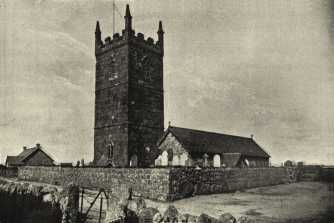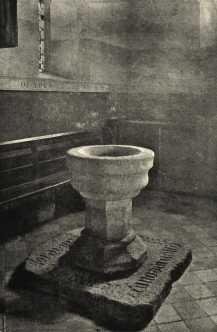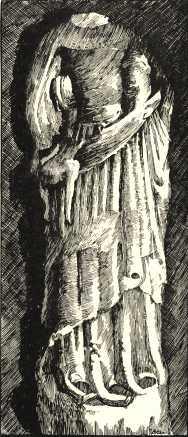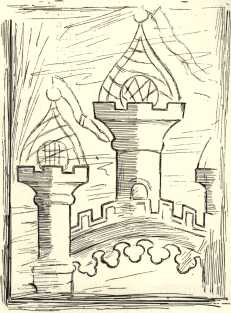The following description is lifted directly from [Quiller-Couch 1899] from an article written by Thurston C. Peter entitled “St. Sennen”. It must be read in the context of that date. The contemporary photographs are by J. C. Burrow, of Camborne and were printed with the original article.

ST. SENNEN CHURCH
OF this saint but little is known. There is a short account of him in Alban Butler’s ‘Lives,’ and in Colgan’s ‘Acta Sanctorum.’ In the life of St. Kieran we come across him for a moment. That saint, having given his upper garment (his cuculla) to a beggar, is met by Sennen while wearing only his pallium (or under garment), and gravely rebuked: ‘Fie on a priest who walks about in one garment only, without his hood!’ They were evidently particular in those days as to the garments worn; and perhaps it was as well, for in many instances the cowl did ‘make the monk,’ and was the only ‘religious’ thing about him. He is supposed to be the same person as St. Senan of Iniscathy, an Irish abbot of the sixth century, but the identity is by no means certain. The Irish St. Senan was a native of County Clare, and the child of noble parents — in fact, his father was, like most Irishmen, of royal blood. The Irish martyrologies further tell us that his parents were Christians, but what little we know of them hardly confirms the statement.
His parents were ‘moving house,’ when Senan, instead of lending a hand, knelt down to prayer, on which his ‘Christian’ mother poured cold water and strong language on him, but without effecting her object. As, however, Senan resumed his prayer the domestic utensils of the establishment were by some unseen agency removed from the old abode to the new. Shortly after he was compelled by the Prince of Corco-baskin to join a marauding expedition, but managed to avoid taking any part in the evil that was wrought. His party was defeated and he was allowed to go whither he would. He then studied under the abbot Cassidan, and, having received the monastic habit, entered the monastery of St. Naal, where he spent some years. He is reported to have been a proficient in piety and learning; but the only acts of his life in the monastery that have come down to us cannot be regarded as strict proof of these attainments. On one occasion he (by a miracle) prevented the calves which he was tending from having their natural nourishment, for fear the brethren would not have milk enough; and on another, when observed by a monk while using the fingers of his left hand as candles whereby to read at night,1 he was so annoyed that he said: ‘For prying a stork shall peck out your eye,’ which a stork accordingly did, and, at the command of St. Naal (whose views of piety were apparently of a higher standard), St. Senan had to replace the eye and cure the wound, which, being a saint, he of course at once did without difficulty. We cannot follow him through all the actions of his life — his dispute with Lugadh, Prince of Inis-carra; his erection of a church on Inis-luinge, in the Shannon; his voyage thence to Inis-mor, and his compulsory visit to Inis-tuaiscert, whither he was driven by adverse winds, and where (regarding the winds as expressive of the will of God) he erected a church. Arrived at Inis-mor (Inchmoor, at the junction of the Fergus with the Shannon), he founded the monastery over which he for some time successfully presided. For some reason, however, he left here and, in spite of the opposition of the prince, founded another monastery on the island of Inis-cathaig. To this island came the holy St. Kannera, a nun of Bantry, who, in spite of Senan’s rule that no woman should set foot upon the island, was resolved to receive from his hands the Viaticum, and to lay her bones on the forbidden soil. Probably if no such rule had been made St. Kannera would have been quite content to be buried at home. St. Senan, however, met her boat and stopped her on the shore, quaintly asking: ‘What have monks in. common with women?’ The lady closed the discussion by saying: ‘I will die before I go back,’ and promptly did so, and was buried where she fell.
When St. Senan himself died his obsequies were celebrated in a manner that showed him to have been held in great veneration. It is a pity these martyrologies are filled with so much trash, for probably, did we know the truth about St. Senan, we should find him to have been a very ordinary and respectable man, with a desire to lead a true and pious life of usefulness, and perhaps without any pretence at being a miracle-monger. Some of the martyrologies contain a tale of St. Senan even more foolish than those already given; they state that as the corpse was being carried to the grave it sat up and directed that his anniversary should be held on March 8 instead of on the 1st. He gave no reasons, but his directions have been respected, and his anniversary is on March 8, while the feast day of the parish is on June 30.
1 We are not clear as to what is intended in this legend, which is common to several other Irish and Scottish saints, notably Saints Columba and Kentigern.
This interesting church, which, like St. Levan, was a parochial chapelry to St. Buryan,2 stands on high ground, and its weathered granite walls and tower tell of the many storms to which it has been exposed. The large blocks of stone of which it is built (there are only thirty-three courses in the tower) do not give this church the flat appearance often produced by this style of building, but add to it a dignity and grace which well suit its situation. The cottages around, many of which appear to be as old as the church itself, increase the feeling of age, and, moreover, help one to realise its history. It consists of chancel, nave, north transept and south aisle (with porch), and western tower, of three stages and 18 feet 4 inches at the base , each stage receding slightly from the one below it, and the battlemented parapet projecting to the plane of the second stage.

FONT AND DEDICATION STONE
The stairs are at the north-west corner in the thickness of the wall. The hood-moulded two-light windows in each face of the uppermost stage, and in the west face of the lowest stage, are apparently the only original windows left in the church. A four-centred doorway with hood-mould in the west face is closed, but has not been built up. The soil of the churchyard reaches to about one-third of the height of this door. The tower opens into the nave by an obtuse-pointed arch carried on ovolo corbels, within another plain soffit arch.
Within the church you know at once that you are in presence
of a restoration by the late Mr. Piers St. Aubyn strong,
lasting work, with little apparent love of the old traditions,
and with an utter absence of poetry; and all the details
(especially the roof timbers) are of the same type as in every
other church he either built or restored.  The restoration of 1867
certainly was needed, however, for the church was in a decayed
and dirty condition, and the tracery of all the windows (except
in the tower) had been destroyed and replaced by timber. There
is one window (now built up) in the south wall of the chancel
which may perhaps have been there before the transept on that
side was replaced by the present aisle; for the aisle, which is
only 5½ feet shorter than the chancel, covers the western
portion of it. It is a square-headed window, and had fornerly a
hood-mould, now removed.
The restoration of 1867
certainly was needed, however, for the church was in a decayed
and dirty condition, and the tracery of all the windows (except
in the tower) had been destroyed and replaced by timber. There
is one window (now built up) in the south wall of the chancel
which may perhaps have been there before the transept on that
side was replaced by the present aisle; for the aisle, which is
only 5½ feet shorter than the chancel, covers the western
portion of it. It is a square-headed window, and had fornerly a
hood-mould, now removed.
The aisle is separated from the nave by five four-centred arches, carried on square pillars with three-quarter shafts on each face, the capitals having round and cavetto mouldings.
The transept (which is now occupied by the organ) is connected with the nave by a four-centred arch.
The objects of interest within the church are not nunmerous. The standard poor-box is dated 1732; there is a copy of Charles the First’s letter of thanks hung in the tower, and there is a portion of an old bench-end in the aisle with a monogram similar to that mentioned in the paper on St. Levan, but without the heart in the lower loop. The hexagonal pine pulpit at the eastern respond of the transept arch is modern and poor. But there are three objects of exceptional interest — an inscribed stone, an alabaster figure, and a distemper painting. The stone is now (after many vicissitudes) restored to the place in which the historian Hals found it in 1700, when it served to support the font. The legend is :— Eccla i decole [the l, i and l are, in each case, crossed by a ~] (on the north side) s. i. b. dedica fuit (on the east side) Anno dñi millo (on the south side) CCCCXLI . . . (broken) (on west side); that is, the church was dedicated on the Decollation of St. John Baptist (29 August) in the year of our Lord 144 (1, 2, 3, 4 or 9 as the case may have been).3
 An
interesting alabaster figure, 32 inches in height, is preserved
on a bracket in the transept. Blight speaks of it as probably
representing the Blessed Virgin, and as having been mutilated
by Shrubsall, the Puritan officer of Cromwell’s day, who
is credited with so many sins which he never committed.
However, the figure is certainly much mutilated. It seemed to
us at first as if we could distinctly trace the features of a
head carried in the arms after the manner of St. Sidwell of
Exeter; and the dedication-stone just referred to made us fancy
that it might represent St. John Baptist. But the figure seems
clearly on close examination to be not that of a man, and
Blight’s conjecture is probably correct. The distemper
painting on the east wall of the aisle represents a bridge,
with a round embattled tower finished with a canopy in the
centre, another on the north side, and one side of a similar
tower on the south. Under the bridge water is flowing; but the
painting is too much injured to admit of further description.
It evidently represents the Heavenly Jerusalem.4 On the church-yard wall by the south gate
is the head of a broken cross, having on front and back in each
case four beaded triangles having concave sides, forming a
cross with expanded limbs between them.5 This was removed from a field a short way
off about ten years ago. In the cemetery near by is a very
beautiful cross, 7 feet 2 inches in height, having on each face
a cross, the limbs of which are widened towards their outer
ends; those, however, of the back cross being longer than the
other, and the shaft not resting on a step as does that on the
front.
An
interesting alabaster figure, 32 inches in height, is preserved
on a bracket in the transept. Blight speaks of it as probably
representing the Blessed Virgin, and as having been mutilated
by Shrubsall, the Puritan officer of Cromwell’s day, who
is credited with so many sins which he never committed.
However, the figure is certainly much mutilated. It seemed to
us at first as if we could distinctly trace the features of a
head carried in the arms after the manner of St. Sidwell of
Exeter; and the dedication-stone just referred to made us fancy
that it might represent St. John Baptist. But the figure seems
clearly on close examination to be not that of a man, and
Blight’s conjecture is probably correct. The distemper
painting on the east wall of the aisle represents a bridge,
with a round embattled tower finished with a canopy in the
centre, another on the north side, and one side of a similar
tower on the south. Under the bridge water is flowing; but the
painting is too much injured to admit of further description.
It evidently represents the Heavenly Jerusalem.4 On the church-yard wall by the south gate
is the head of a broken cross, having on front and back in each
case four beaded triangles having concave sides, forming a
cross with expanded limbs between them.5 This was removed from a field a short way
off about ten years ago. In the cemetery near by is a very
beautiful cross, 7 feet 2 inches in height, having on each face
a cross, the limbs of which are widened towards their outer
ends; those, however, of the back cross being longer than the
other, and the shaft not resting on a step as does that on the
front.
The church plate consists of a silver chalice and cover, the latter being used as a paten;6 a silver bread-dish inscribed ‘The gift of Mr. Martin Bosistow, died in the year of our Lord, 1765’; an old silver plate stamped with the letters WNM, each surmounted by a crown; and a glass cruet with silver fittings inscribed ‘Gift of R. J. Roe, M.A., 1872.’7
The bells, which were restored by Messrs. Mears and Stainbank in 1889, are five in number:
The Parish Registers begin in 1700.
2 Apparently it was not a Capella curata (or Parochialis) as early as St. Levan, which latter alone is mentioned io the Inquisicio Nonarum of 1340. Probably, however, there was a chapel here from very early times, to which a ‘parish’ was assigned later on.
3 Extended, the legend reads ‘Ecclesia in Decollacione S. Iohannis Baptiste dedicata fuit Anno Domini Millesimo ccccxli. …’
4 See Rev. xxi. 13.
5 It is shown in the view of the church.
6 We are told this chalice and paten cover are Elizabethan, but have not ourselves seen them.
7 Mr. Roe was the Rector.